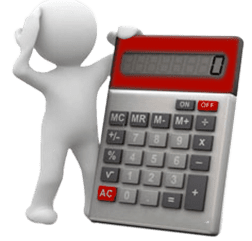Emergency Value Selling. B2B value selling often gets started as firefighting. At a critical moment late in a sales or renewal process,  the alarm goes off. An analytical person on the commercial team, perhaps a product manager or a presales professional, jumps into the fray, putting in extra hours to come up with a spreadsheet and a presentation to put out the fire.
the alarm goes off. An analytical person on the commercial team, perhaps a product manager or a presales professional, jumps into the fray, putting in extra hours to come up with a spreadsheet and a presentation to put out the fire.
There are two types of alarm that usually generate this flurry of activity: (1) a large current customer considering a switch to a new vendor, or (2) a positively- inclined, new customer who needs a business case to get internal approval to buy. First responder equipment usually starts minimalist, a spreadsheet that is very customer-specific, perhaps a few math-heavy slides. Only the author can defend the spreadsheet or present the slides.
inclined, new customer who needs a business case to get internal approval to buy. First responder equipment usually starts minimalist, a spreadsheet that is very customer-specific, perhaps a few math-heavy slides. Only the author can defend the spreadsheet or present the slides.
Outcomes include winning the business at a good price, retaining the business by cutting price, losing to no decision, and losing to a competitor. Regardless of the results, the spreadsheet and the slides are filed away. They are only useful for the next fire if a sales manager is aware of them and communicates the war story among his or her peers. Even then, materials from the first fire fight usually have to be reinvented or overhauled for the second one.
How Fire Departments Get Started. Fire alarms are repetitive events. If firefighting teams keep losing, the business has a bigger problem.  Sales management will turn over and sales teams will be reorganized. If first responders succeed, sales management will realize that they need a replicable way to fight fires. An initial systematic approach may include: (1) one or more (part-time) value experts identified for others to leverage, (2) Value Calculators built and made available to sales.
Sales management will turn over and sales teams will be reorganized. If first responders succeed, sales management will realize that they need a replicable way to fight fires. An initial systematic approach may include: (1) one or more (part-time) value experts identified for others to leverage, (2) Value Calculators built and made available to sales.
Given these origins in crisis, value selling is often characterized in its early stages by the following tendencies:
- Value selling is primarily reactive to customer demands, not proactive.
- Value selling is only deployed late in a sales cycle.
- Strong value selling skills are, at best, limited to a few members of the sales team.
- Value content is heavily financial and analytical. Value content = Value Calculators.
Businesses that build a value fire department can usually justify the investment based on the number of wins. But their investments tend to be suboptimal. And the learnings of value selling are almost never leveraged. This is the world of B2B Value Calculators.
Value Calculators are the Problem. Most Value Calculators are tools designed by experts for experts. They include crucial content about what your solution will deliver to customers, but that content is isolated from the rest of the sales process and is rarely connected to or integrated with other content in the sales library.
 Most B2B sales trainers emphasize the importance of value selling, making it central to their best practices for sales effectiveness. But Value Calculators, as selling tools, are almost never incorporated into a sales training curriculum either because trainers never see them or because trainers see them and recognize that they are too ugly and complicated to use. As a result, value selling is a sales mantra that is typically undertrained and badly implemented.
Most B2B sales trainers emphasize the importance of value selling, making it central to their best practices for sales effectiveness. But Value Calculators, as selling tools, are almost never incorporated into a sales training curriculum either because trainers never see them or because trainers see them and recognize that they are too ugly and complicated to use. As a result, value selling is a sales mantra that is typically undertrained and badly implemented.
Yet value selling’s potential is clear. Forrester Research, surveying buyers, found that, “the first vendor to succeed in communicating a vision to executives wins the business 74% of the time.” The key to that win rate, according to Forrester, is that the winning vendor works with the buyer to turn the vision into “a clear path to value.” The single most important selling skill in Richardson’s 2019 Selling Challenges survey is to “Deliver a Compelling Value Proposition.”
Despite a clear acknowledgement of the importance of value in sales, Value Calculators that should support and complete a qualitative Value Proposition are disconnected from other sales content, excluded from sales training, delivered only by experts, and neglected in sales management reviews with sales reps.
Value Propositions are the Solution. As highlighted in our last blog, great Value Propositions provide content to:
- Help identify the buyer problems or objectives that you address.
- Match your solution to specific buyer problems/objectives, highlighting what your solution has delivered to comparable buyers.
- Draw attention to your differentiated ability to deliver these results.
- Support a buyer’s business case to buy.
Great Value Propositions are different from, and better than Value Calculators. They are easier to use and easier to understand. Strong Value Propositions incorporate other mission-critical content, drive toward what you do for your customers, and create powerful moments in customer conversations. Good Value Propositions are aligned with buyers’ processes through the sales cycle and integrally connected with your sales training approach.
In the hands of good sales teams, great Value Propositions evolve from Flexible Case Studies early in the sales cycle to Customer Value Analyses during a customer evaluation to a Shared Business Case to Buy that helps sales teams speed the time to closing. CRM data from organizations adopting value selling show that opportunities where a Value Proposition is used (1) have 5-15% higher win rates and (2) 5-25% higher price outcomes.
Six Ways Value Propositions Change the Sales Process. We asked LeveragePoint customers how a shift from Value Calculators to digital Value Propositions is changing their sales process. Their answers had six themes:
 Content Quality. Progressing from fire drill spreadsheets to Value Calculators to Value Propositions changes the process of content creation. In designing a Value Proposition, product managers work through the math, connect it to key messages, and provide support for benchmark data and claims. Sales leaders identify account and stakeholder types. Marketing provides branding, design, and relevant content. Internal approval processes and content testing improve a Value Proposition’s quality and its usability. Training, use, and review keep the content current and refine it in a version-controlled way. The result:
Content Quality. Progressing from fire drill spreadsheets to Value Calculators to Value Propositions changes the process of content creation. In designing a Value Proposition, product managers work through the math, connect it to key messages, and provide support for benchmark data and claims. Sales leaders identify account and stakeholder types. Marketing provides branding, design, and relevant content. Internal approval processes and content testing improve a Value Proposition’s quality and its usability. Training, use, and review keep the content current and refine it in a version-controlled way. The result:
- “Since we started getting more systematic with Value Propositions, our reps have confidence that they have up-to-date, relevant content.”
- “Reps who wouldn’t touch our ROI calculators like the look and feel of the value presentation.”
- “The predictable format of our value prop helps reps identify customer specifics in natural conversations.”
- “When our solution consultants are introduced, the reps have already captured information about what is important to the account. This guides solution consultant demos and helps them suggest impactful implementation programs.”
 Efficient Call Preparation. A well-designed Value Proposition provides a road map for customer conversations. As a result, it reinforces sales skill training. It becomes a go-to place to prepare more informed questions, to identify key issues for discovery and to think through what vision of value is most likely to resonate with a specific target.
Efficient Call Preparation. A well-designed Value Proposition provides a road map for customer conversations. As a result, it reinforces sales skill training. It becomes a go-to place to prepare more informed questions, to identify key issues for discovery and to think through what vision of value is most likely to resonate with a specific target.
- “Our reps are reaching for the value prop as early as their first or second call. They have up-to-date, relevant content without hunting around, building their own slide decks and calling other reps.”
- “One new account rep told me that she chooses the right Value Proposition and looks at three or four value drivers before a prospecting call. It helps her come up with questions and themes about what our product does.”
- “If a rep has started a Value Proposition for an account, that is where our sales engineers start when they get ready for their first meeting. If there is no value prop, one of our sales engineers has started to ask, ‘Why not? Should we be spending time on this account?’”
 Ability to Tell a Story. Designing a Value Proposition to support a narrative has real sales benefits. Customer case studies, whether or not the customer is specifically named, support story-telling as a way to engage a customer. When a case study or some other example is flexible and displays assumptions, it provides a way to replace interrogation-style discovery with conversational discovery. A good narrative also gets at what the buyer wants to understand: what you can deliver. When a buyer compares their situation to a successful customer, it helps to frame the buyer’s mindset for a potential purchase.
Ability to Tell a Story. Designing a Value Proposition to support a narrative has real sales benefits. Customer case studies, whether or not the customer is specifically named, support story-telling as a way to engage a customer. When a case study or some other example is flexible and displays assumptions, it provides a way to replace interrogation-style discovery with conversational discovery. A good narrative also gets at what the buyer wants to understand: what you can deliver. When a buyer compares their situation to a successful customer, it helps to frame the buyer’s mindset for a potential purchase.
- “One rep who had tried calculators liked the new tool. ‘That ROI calculator was threatening to a customer. It didn’t give me a way to introduce what we could do for the account without math. A case study is different. It lets me get a buyer asking questions instead of me defending assumptions.’”
- “When we used our Value Calculator last year, management told us it was a tool to validate price increases. It didn’t take long for accounts to recognize that. When we pulled out the calculator, they clammed up and called procurement.”
- “The Value Proposition does more than letting us talk about ‘why buy?’ It lets our reps talk about how other accounts have succeeded. The “how” part of that discussion shows that we know what we are doing. Matching that other account up with a current buyer and identifying differences helps us to customize a solution and a focus for onboarding.”
- “With a Value Calculator, I felt like I had to get all my assumptions right. With a Value Proposition, it’s more organic. Now it’s rare when someone on the buyer’s side goes through our list of assumptions to make sure they are conservative enough.”
 Enhance Customer Trust. Getting buyers to talk is good. Buyers tend to talk more when they think a sales team understands them. Good Value Propositions are customer-centric, helping to identify buyer problems and priorities. The market intelligence embedded in Value Proposition content can be used by good sales teams to convey their understanding of and expertise in the buyer’s business problems. Value Proposition narratives and good questions arising from that narrative entice a buyer to communicate their problems and priorities.
Enhance Customer Trust. Getting buyers to talk is good. Buyers tend to talk more when they think a sales team understands them. Good Value Propositions are customer-centric, helping to identify buyer problems and priorities. The market intelligence embedded in Value Proposition content can be used by good sales teams to convey their understanding of and expertise in the buyer’s business problems. Value Proposition narratives and good questions arising from that narrative entice a buyer to communicate their problems and priorities.
- “The list of assumptions and questions in our old Value Calculator got in the way. Reps on autopilot to get through the discovery checklist rarely got their customers talking. A Value Proposition with a story is much better for getting a decision-maker who is willing to share.”
- “I ended up with one account who challenged the math in our Value Calculator. I shared the spreadsheet with them and they got lost in the formulae. The math in our Value Proposition is easier to follow.”
- “The finance person at the customer said that they liked the ability to audit our math.”
- “Our buyers have scientific backgrounds. They talk a lot about evidence. It’s interesting that our case study itself serves as evidence. Also, having answers to the first few questions about assumptions right there really helped keep the meeting from turning into a non-stop stream of buyer questions.”
 Broaden Value Selling. Relying on subject matter experts, product managers and value engineers for value selling is natural at many organizations. This practice is usually a consequence of the complexity of the Value Calculators that these experts create. Yet the best sales reps do napkin math all the time. They have the business acumen and common sense to mix it up with customers. The problem is that they do it on the fly. They don’t have time to put their math in a form that a customer can understand or use internally. And other reps don’t learn from their best work. Value Propositions bridge the gap, providing sales-ready content that reps can use without trepidation, can be shared with customers, and can be used by other reps. This helps overcome the myth that you have to have an MBA to talk about value.
Broaden Value Selling. Relying on subject matter experts, product managers and value engineers for value selling is natural at many organizations. This practice is usually a consequence of the complexity of the Value Calculators that these experts create. Yet the best sales reps do napkin math all the time. They have the business acumen and common sense to mix it up with customers. The problem is that they do it on the fly. They don’t have time to put their math in a form that a customer can understand or use internally. And other reps don’t learn from their best work. Value Propositions bridge the gap, providing sales-ready content that reps can use without trepidation, can be shared with customers, and can be used by other reps. This helps overcome the myth that you have to have an MBA to talk about value.
- “Reps ran away from our Value Calculator. The calculator looked ok, but there was too much fear that reps would get questions they couldn’t answer. Our softer value prop approach with more of a story has enhanced rep confidence.”
- “Our value engineers used to take the approach of making sure they personally touched every big deal that they could. We had to incentivize change, but we told them that they should cut their previous number of customer presentations in half and use what they learned from those meetings to create Value Propositions that any sales rep could use. We had some hiccups, but it is working.”
- “Our Value Propositions have nice-looking, customized leave-behinds that let a rep come up with a business case without calling in the experts.”
 Earlier Use of Value Selling. If you believe the Forrester survey of buyer executives, sales teams should all be targeting value conversations early in the sales cycle. Value conversations help differentiate your solution and give buyers a reason go forward with an evaluation instead being stuck with the status quo. Detailed Value Calculators arising from fire drills are almost never oriented toward introducing value early in the buying process. Broadening the usefulness of Value Propositions beyond the experts to the generalist sales rep and supporting value narratives promotes earlier value conversations.
Earlier Use of Value Selling. If you believe the Forrester survey of buyer executives, sales teams should all be targeting value conversations early in the sales cycle. Value conversations help differentiate your solution and give buyers a reason go forward with an evaluation instead being stuck with the status quo. Detailed Value Calculators arising from fire drills are almost never oriented toward introducing value early in the buying process. Broadening the usefulness of Value Propositions beyond the experts to the generalist sales rep and supporting value narratives promotes earlier value conversations.
- “Skeptical buyers want to understand why they should spend time on our product. The case study we use points to what we can deliver in a subtle way. That helps to move an opportunity forward.”
- “We used to be stuck defending value directly with procurement when they pushed our reps at negotiation time. Now we are getting potential champions in the business to realize what we can deliver for them earlier. Our reps can help buyer sponsors build a business case that they can use internally.”
- “Our reps are spending less time with procurement and more time with production and operating teams.”
- “We train our reps to summarize our value prop in 3 or 4 sentences in case they get access to a senior executive.”
Value Propositions Align Sales Teams with Customers. Value Propositions change the way your sales teams sell. Unlike Value Calculators, they focus sales teams on customer problems with relevant content that helps to tell a story about what you deliver. The best B2B enterprises deploy Value Propositions to improve B2B sales performance, addressing sales challenges in a way consistent with an organization’s sales training, throughout the B2B sales cycle. It isn’t hard to start value selling. Value Propositions are a shared basis to build customer trust that help sales teams win.
For additional perspectives on sales use of Value Propositions, read:
Using Propositions as an Effective Sales Tool
For more information on designing Value Propositions for Account-Based Selling, check out:
Value Propositions for Your Customer Audience

